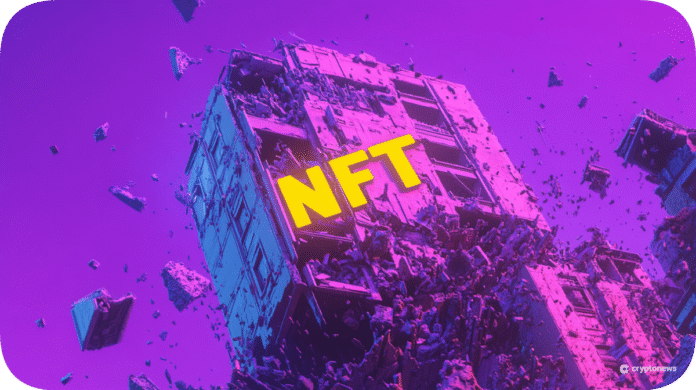The non-fungible token (NFT) credit market has experienced a significant decline in volume and user activity. According to a report by Blockchain Analytics platform DappRadar, published on May 27, the NFT credit market in May 2025 has decreased from almost $1 billion to just over $50 million, representing a 97% drop compared to its peak in January 2024.
This decline is attributed to several factors, including the end of speculative incentives, falling NFT prices, and a wave of liquidations. Sara Gherghelas, from DappRadar, told Cryptonews that the early activity in the NFT credit market was driven by airdrops and farming, especially on platforms like Blur. However, when these incentives dried out, the volume also decreased. Additionally, falling NFT prices led to a wave of liquidations, causing dozens of NFT credit protocols to become inactive, leaving only a few major players.
One of the major players in the NFT credit market is NFTFI, an NFT credit platform created in 2021. Aristide Bui, NFTFI CMO, told Cryptonews that the sector is undergoing changes, but it’s essential to consider the entire picture of the credit market. “NFTFI pioneered the NFT loan in 2021 when the total debt was only $100,000,” said Bui. “Today, the market is well-developed, with platforms like Mix, Gondi, and others contributing to a current outstanding debt of around $82 million.”
Bui added that the credit market at its peak in March 2024 reached $175 million in outstanding debts, more than twice the number today. According to CoinmarketCap, the current overall market capitalization for NFTs in Ethereum is around $7 billion. “With $78 million currently being lent, this is just a little over 1% – this is extremely low compared to mature sectors like real estate, in which debts can make up 20% of the market. This indicates that there is still considerable space for growth and penetration,” said Bui.
Despite the decline, Gherghelas believes that NFT loans are far from dead, but rather maturing. “The entire sector shifts from a speculative hype cycle to a niche that is mainly used by experienced collectors and DeFi-savvy users,” she said. The use of art NFTs, such as Fidenzas and Autoglyphs, on credit platforms like Gondi has increased, indicating a shift towards cultural value and origin.
Max Gammario, CEO of NFT and AI platform Kindred, told Cryptonews that the NFT credit sector is not decreasing, but rather experiencing a necessary liquidity crisis that forces a fundamental re-calibration. “The volumes have dropped significantly from top levels, but this only reflects the collapse of speculative collateral values as a lack of underlying demand,” he said. Gammario explained that most NFT credit platforms built their models around volatile, illiquid NFTs as collateral, generating a fragile system.
Tokenized real assets (RWAS) could provide more stable, low-risk collateral and solve the volatility problem that has long plagued NFT loans. Gherghelas believes that RWAS, such as real estate shares or tokens invoiced, could offer predictability and stronger incentives for lenders to participate. Projects like REALTYX, a RWA platform for real estate, and a platform that creates physical collectors into digital assets, are beginning to materialize through early integrations and infrastructure development.
Yat Siu, co-founder and executive Chairman of Animoca Brands, told Cryptonews that tokenized RWAs are indeed a strong application for NFTs and can be used as collateral. Siu explained that tokenized RWA-NFTs can be used for various assets, including real estate, for which the security amount for lending is sufficient. However, he noted that this area requires stronger institutional support and better credit market development.
The NFT credit market still has to grow, and Siu expects that there will be a revival of public interest in NFTs. “If the crypto market improves and prosperity is created, the demand for NFTs will also increase, since NFTs represent the cultural, social, and symbolic status elements of our modern digital life,” he said. Siu also pointed out that institutional adoption is always a deceased participant, but it becomes clear that there is a strong interest in the market for fungible tokens.
Aristide Bui believes that the NFT loan is still in the early stages of innovation. If volatility decreases and use cases expand in practice, he thinks that lending will be one of the most important pillars that will bring sustainability and financial benefits to the NFT ecosystem. “Loans introduce an earnings component that enables long-term added value, especially for lenders,” said Bui. “At NFTFI, we see that the market is maturing, and our product is tailored to the needs of advanced participants such as institutional funds and large-scale borrowers.”
For more information, visit the source link: https://cryptonews.com/news/nft-lending-volume-crashes-97-dappradar/

